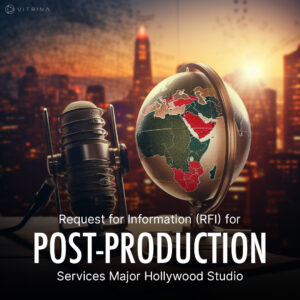Looking for a localisation company? Here's how to find the best localisation projects in Film and Television


Financing in Film and Television
Financing is the process of raising money to produce a film or television project. It involves acquiring the necessary funds to cover all the costs of production, including pre-production, production, and post-production. The cost of producing a film or television show can be quite significant, and thus, financing is an integral part of the production process.
Here are some of the ways in which financing can be raised for film and television productions:
Studio financing
The most common form of financing for film and television productions is studio financing. Studios have their own financing departments that provide the funds required to produce films and television shows. They offer a range of financing options, including loans, advances, and investments. In return, studios retain the rights to the finished product and take a share of the profits.
Examples of Studio Financing –
- Warner Bros: Warner Bros. is one of the largest studios in Hollywood and has been involved in the financing of numerous films and TV shows over the years. Some of their recent film productions include “Wonder Woman,” “Joker,” and “Tenet.”
- Disney: The Walt Disney Company is another major player in the film and television industry. Disney has financed many blockbuster films such as the “Marvel Cinematic Universe” movies, the “Star Wars” franchise, and their animated films like “Frozen” and “Moana.”
- Universal Studios: Universal Studios is another studio that provides financing for films and television productions. They have produced several successful franchises, including “Jurassic Park,” “Fast and Furious,” and “Despicable Me.”
- Sony Pictures: Sony Pictures Entertainment is the film and television division of the Japanese conglomerate Sony Corporation. Some of their most popular film franchises include “Spider-Man,” “Men in Black,” and “Jumanji.”
- Paramount Pictures: Paramount Pictures is a film and television production company that has been around for over 100 years. They have financed many successful films and TV shows, including “Mission: Impossible,” “Transformers,” and “Star Trek.”
Track recent Studio Financing projects on Vitrina
Equity financing
Equity financing involves raising funds by selling shares in the film or television production company. Investors who purchase these shares become part owners of the production company and share in the profits. Equity financing can be an attractive option for filmmakers who want to maintain creative control of their projects while raising capital.
Examples of Equity Financing-
- A24: A24 is an independent entertainment company that produces and distributes films and TV shows. It has raised equity funding from investors, including media conglomerate 21st Century Fox and venture capital firm Raine Group. A24 has produced several critically acclaimed films, including “Moonlight,” “Lady Bird,” and “Uncut Gems.”
- Legendary Entertainment: Legendary Entertainment is a film and television production company that has raised equity funding from investors such as Softbank and Wanda Group. Legendary has produced several blockbuster films, including “Jurassic World,” “Godzilla,” and “Pacific Rim.”
- STX Entertainment: STX Entertainment is a media company that produces and distributes films and TV shows. It has raised equity funding from investors, including Hony Capital and Tencent. STX has produced several successful films, including “Hustlers,” “The Upside,” and “Bad Moms.”
- Participant Media: Participant Media is a media company that produces and finances films and TV shows with a social message. It has raised equity funding from investors, including Jeff Skoll and the Ford Foundation. Participant has produced several award-winning films, including “An Inconvenient Truth,” “Spotlight,” and “Green Book.”
- FilmNation Entertainment: FilmNation is an independent film production and international sales company. It has raised equity funding from investors such as Lloyds Banking Group and Access Industries. FilmNation has produced several critically acclaimed films, including “Arrival,” “The Big Sick,” and “Uncle Frank.”
Crowdfunding
Crowdfunding has become an increasingly popular way to finance film and television productions. It involves raising funds from a large number of individuals through crowdfunding platforms such as Kickstarter and Indiegogo. Crowdfunding allows filmmakers to connect directly with their audience and get them involved in the production process.
Examples of crowdfunded content
- “Veronica Mars” (2014): The Kickstarter-funded movie based on the cult TV series of the same name was a box office hit, grossing over $3.5 million worldwide on a budget of $6 million. While it didn’t break any box office records, the film’s success proved that crowdfunding could be a viable financing option for studio productions.
- “Super Troopers 2” (2018): The sequel to the 2001 comedy “Super Troopers” was produced with the help of a successful crowdfunding campaign on Indiegogo, raising over $4.6 million. The film grossed over $31 million worldwide, proving that crowdfunding could be used to finance commercially successful movies.
- “Gosnell: The Trial of America’s Biggest Serial Killer” (2018): This independent film about the trial of abortion doctor Kermit Gosnell was partially funded through a successful crowdfunding campaign on Indiegogo, raising over $2.3 million. The film went on to gross over $3.7 million at the box office, becoming one of the most successful crowdfunded films in history.
- “Iron Sky: The Coming Race” (2019): The sequel to the 2012 cult hit “Iron Sky” was financed through a successful crowdfunding campaign on Indiegogo, raising over $2.5 million. The film went on to gross over $9.4 million worldwide, proving that crowdfunding could be used to finance sci-fi movies with niche audiences.
- “The Endless” (2017): This indie horror film was financed through a successful crowdfunding campaign on Kickstarter, raising over $103,000. The film went on to gross over $770,000 at the box office, becoming a cult hit and proving that crowdfunding could be used to finance successful genre films.
Gap financing
Gap financing is used to fill the funding gap between the total cost of production and the amount of financing already secured. Gap financing is typically used to cover the costs of post-production, such as editing, sound design, and visual effects.
Example of gap financed projects
- The Wolf of Wall Street (2013): This movie, directed by Martin Scorsese and starring Leonardo DiCaprio, was financed through a combination of studio financing and gap financing. Red Granite Pictures, the film’s production company, used gap financing to cover a budget shortfall during the production process.
- The Imitation Game (2014): This biographical drama about the life of mathematician Alan Turing was partially financed through gap financing provided by Bristol Automotive, a UK-based automotive company.
- The Grand Budapest Hotel (2014): This Wes Anderson film was financed through a combination of equity financing, studio financing, and gap financing. The film’s production company, Indian Paintbrush, used gap financing to cover unexpected expenses that arose during the production process.
- The Shape of Water (2017): This Guillermo del Toro film was financed through a combination of equity financing, studio financing, and gap financing. The film’s production company, Bull Productions, used gap financing to cover a budget shortfall during the production process.
- La La Land (2016): This musical film, starring Emma Stone and Ryan Gosling, was financed through a combination of studio financing and gap financing. Lionsgate, the film’s distributor, used gap financing to cover additional production costs that arose during the filming process.
Ever wondered how Netflix finances their original productions? Here's how
Debt financing: Netflix has historically relied heavily on debt financing to fund its original content production. The company has issued a significant amount of debt in the form of bonds and loans to finance its growing content budget, which was estimated to be around $17 billion in 2021. Netflix has a good credit rating and is able to access the debt markets at low interest rates, which allows them to fund their content production while also keeping their costs low.
Content licensing: Another key component of Netflix’s financing model is content licensing. The company licenses content from third-party studios and producers, as well as acquiring the rights to content created by other companies. This allows Netflix to offer a wide range of content to its subscribers without having to invest in the production costs themselves.
In addition, Netflix also uses other forms of financing, such as private equity and co-production deals, to fund some of their original content. The company has also experimented with crowdfunding for some of its smaller projects.
International co-productions
International co-productions involve partnering with production companies from other countries to share the costs of production. This form of financing is often used to take advantage of tax incentives and other financial benefits offered by different countries. There are several thousand examples of content produced under co-production deals.
Some examples of co-produced content
- The King’s Speech (2010): This historical drama, directed by Tom Hooper and starring Colin Firth, was a co-production between British and Australian production companies. The film went on to win four Academy Awards, including Best Picture.
- The Irishman (2019): This crime drama film directed by Martin Scorsese and starring Robert De Niro, Al Pacino, and Joe Pesci was a co-production between Netflix and various other production companies, including Tribeca Productions, Sikelia Productions, and IAC Films.
- The Grand Budapest Hotel (2014): This Wes Anderson film was a co-production between American, British, and German production companies. The film went on to receive nine Academy Award nominations, winning four.
- Amélie (2001): This French romantic comedy film, directed by Jean-Pierre Jeunet, was a co-production between French and German production companies. The film was a critical and commercial success, winning numerous awards and nominations.
- Rush (2013): This biographical sports drama film, directed by Ron Howard, was a co-production between American and British production companies. The film received positive reviews and was nominated for two Academy Awards.
- The Handmaid’s Tale (TV series, 2017- ): This dystopian drama series, based on the novel by Margaret Atwood, is a co-production between American and Canadian production companies. The series has received critical acclaim and numerous awards, including multiple Primetime Emmy Awards.
Debt Financing
Debt financing in film and television is a funding model that involves borrowing money from financial institutions or private investors to finance the production of a film or TV show. This form of financing typically involves the production company securing a loan, with interest, that will be paid back over time.
Debt financing can be used to fund various aspects of production, including pre-production, production, post-production, and marketing. Some common expenses that may be covered by debt financing include salaries and wages for cast and crew, equipment rentals, location fees, and post-production services such as editing and visual effects.
One advantage of debt financing is that it allows the production company to retain full control over the creative and financial aspects of the project, without having to share profits or ownership with outside investors. However, it also carries a significant risk as the loan must be paid back with interest, regardless of the success of the project at the box office or through distribution deals.
Debt financing is typically used in conjunction with other financing models, such as equity financing or pre-sales, to fully fund a project. The availability and terms of debt financing can vary depending on factors such as the budget and scope of the project, the experience and track record of the production company, and the state of the film and television industry at the time of financing.
Negative Pick up
Under a negative pickup deal, the producer secures the necessary financing to make the project, and the distributor or studio agrees to distribute and market the finished product. The distributor or studio may also provide additional financing during the production process, known as “gap financing.”
Once the project is completed, the distributor or studio takes ownership of the finished product and pays the producer a predetermined price for the distribution rights. This price is usually based on the estimated cost of production, plus a premium.
The term “negative pickup” refers to the fact that the distributor or studio is “picking up” the completed project from the producer, rather than the other way around. It is called “negative” because the distributor or studio is assuming the risk that the project may not be successful at the box office or in the television ratings.
Here are some examples of recent negative pick ups-
- The Revenant (2015)
- The Irishman (2019)
- The Big Short (2015)
- The Marvelous Mrs. Maisel (TV series, 2017-2021)
- The Crown (TV series, 2016- )
- Stranger Things (TV series, 2016- )
- Ozark (TV series, 2017- )
- Narcos (TV series, 2015-2017)
- The Handmaid’s Tale (TV series, 2017- )
- The Queen’s Gambit (TV series, 2020)
In each of these cases, the production company secured a distribution deal with a distributor before the project was produced.
Pre-buy
Under a pre-buy arrangement, the broadcaster or distributor agrees to provide a certain amount of financing to the producer, which is typically based on the estimated cost of production. In exchange, the broadcaster or distributor acquires the right to broadcast or distribute the completed project once it is finished.
Pre-buy arrangements are often used in the television industry for series production, where broadcasters or distributors commit to purchasing a specific number of episodes of a series before it is made. This financing agreement can provide the producer with the necessary funding to produce the series, while also guaranteeing distribution and broadcast for the finished product.
In film, pre-buy arrangements can provide a similar guarantee of distribution for the completed project, although they are less common than negative pickup deals or other forms of financing.
Pre-Sales
Under a pre-sales arrangement, a producer will approach international distributors or sales agents and offer them the opportunity to buy the distribution rights to a project before it has been made. The distributor or sales agent will commit to paying a certain amount for the distribution rights, which is typically based on the estimated cost of production and the projected value of the finished project.
Pre-sales agreements are often used to secure financing for larger-budget film and television projects. By selling distribution rights before the project has been produced, the producer can secure the necessary financing to complete the project, while also guaranteeing distribution for the finished product.
The advantage of pre-sales agreements is that they provide a degree of certainty for both the producer and the distributor. The producer can secure the necessary financing to complete the project, while the distributor can acquire distribution rights to a potentially valuable project before it becomes widely available.
However, pre-sales agreements can also come with certain risks. The distributor assumes the risk that the project may not be successful or may not meet their expectations, while the producer assumes the risk that the project may not be completed on time or within budget.
Grants and loans
This type of funding is usually provided in the form of grants or loans and is used to cover a range of production costs, including script development, pre-production, production, and post-production.
Here are some of the ways in which funding can be secured for film and television productions:
Government funding: Government bodies provide funding for film and television productions through various grants and tax incentives. In some countries, such as Canada and Australia, the government provides significant financial support for the film and television industry.
Private foundations: Private foundations provide funding for film and television productions through grants. These foundations typically focus on supporting specific types of films, such as documentaries or socially conscious films.
Corporate funding: Corporations provide funding for film and television productions as a form of advertising or corporate social responsibility. This form of funding is typically used to finance product placement or to support socially conscious projects.
Film festivals: Film festivals provide funding for film and television productions through cash prizes and awards. Winning an award at a film festival can provide valuable exposure and help secure additional funding.
Some examples of Film and Television content financing & funding companies
- British Film Institute, UK
- Screen Australia, Australia
- Bondt Media Capital, USA
- Three Point Capital, USA
- Royal Bank of Canada, Canada
- Natixis Coficiné, France
- Embankment Films, USA
- Head Gear Films, UK
- CJ E&M Film Financing, South Korea
- BNP Paribas Fortis Film Fund, France
- TUI Insurance Consultants Ltd., Hong Kong
- Greek Film Center, Greece
- The Bell Fund, Canada













































